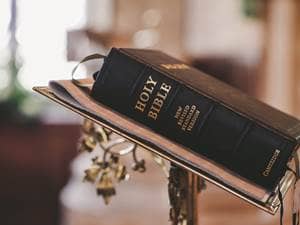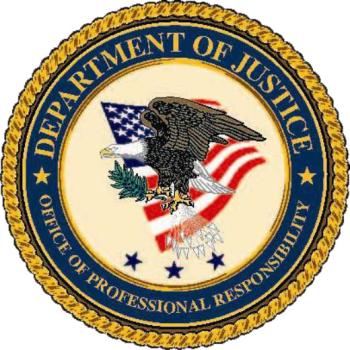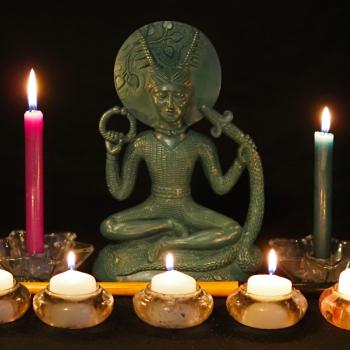
Conjures up some awkward images, "altar frontal." A Chaucerian priest raising his cassock at Sunday Mass to reveal the Paschal candle underneath. Not a pretty picture. Be not afeared, though, little flock. An altar frontal is merely the cloth that adorns the Lord's Table. The priest will choose different altar frontals — a regrettable term, isn't it? — as the liturgy dictates. Purple for Lent or Advent. White for the Blessed Virgin, Christmastide or Epiphany. Red for Pentecost or Martyrs' Feasts. Green for Ordinary Time. But a new trend has lately arisen too: the political altar frontal, often seen embellishing progressive congregations. This tendentious textile has no liturgical significance, and its underlying concept is dubious.
Picture this—a rented warehouse on the posh end of town for a sanctuary. Enter through a door propped open by miscellaneous paperbacks on how to go vegan. Some indie, here-today-gone-tomorrow Christian band serenades a clucking clutch of bearded apostles over the PA system. Chill vibes. One of those foldable garden tables for an altar. Doubles as a rentable stall for the annual knitwear sale fundraiser. And in the midst of it all is a Pride-striped altar frontal. It's Urban Outfitters does Jesus. Minus only the houseplants, vinyl and well-being crystals. Welcome to hipster church!
I jest, of course. If celebrating the holy mysteries on a Gilmore Girls reunion set is your jam, then that's your jam. All this ecclesiastical hipsterishness has its place, no doubt… Except, and hear me out on this one, the Pride-striped altar frontal. My intense dislike of Pride stripes on an altar frontal isn't anti-LGBT—quite the opposite. I couldn't be more liberal, in the British sense of that shapeshifting word, on LGBT rights. That's not the issue. For me, rather, the Pride-striped altar frontal symbolizes a misguided approach to LGBT inclusion, an erroneous philosophy to which I take strenuous exception.
A few fringe outliers aside, I'd say that most LGBT people resent any patronizing attempt at reducing us to one facet of our identity. There are some who vaunt their LGBTness as a prime personality trait. However, most of us find this attitude incomprehensible, as far as I can gather. Perhaps it's the lingering mystique of homosexuality having been illegal in the West and still forbidden across much of the developing world. (Anything criminal does engender idle curiosity.) Praise God we've come a long way since Alan Turing. But surely, the goal of equality, which is not yet secure, is to become as unremarkable for our immutable traits as anyone else.
This brings me to Pride-striped altar frontals. I warmly applaud the good intentions behind this innovation with all sincerity. On the face, it seems a bold way to make a statement of inclusion. What I so disdain about it are the presuppositions it represents about what LGBT people need and want out of Christian fellowship. One such assumption is that LGBT people enjoy getting constantly reminded that we're different. You are special. Not in the Max Lucado sense, however. You're a little more special than everyone else. A little below the angels but somewhere above straight, cisgender people.
Fairness demands that LGBT people access a worship experience the same as that from which everyone else can benefit. Equality before God is a given, or it should be. The sneering sermon of a Pride-striped altar is, on the other hand, "You're different. You'll never blend in. And I'm here to make sure you damn well know it." Exalting one demographic as a notch above others is just as perverse as denigrating them as less-than. So human identity symbols on an altar, that supremely sacred space, are nothing but agents of division. We stand on an equal footing before Almighty God.
Another assumption is that unless draped in Pride stripes, the Lord's Table isn't accessible in some metaphysical way for LGBT people. We need a fancy tablecloth to help us traverse this metaphysical gap like the curtain door to the Holy of Holies. Liturgical colors are for straight, cisgender people, you see. The rest of us need a personal affirmation of our worth coded into the Church's draperies lest we lose the run of ourselves. Only serving Communion over Pride stripes can quell that existential angst. We're so needy; they seem to think… I'd wager, though, that many LGBT people find this toe-curling and like to see liturgical colors in their full use.
More than this, leaving a rainbow flag on the altar all year defeats the purpose of using one color at a time to mark out one liturgical season from another. It's Pentecost, Easter and Lent all at once when Pride stripes are on display. Christ is daily killed on a cross (red stripe) during both Ordinary Time (green stripe) and the Lenten 40 days (purple stripe). A hideous mongrel of assorted liturgy from Pastor Frankenstein's underground lab, a mush of everything packed into a single omnibus. Further, some Pride colors don't even serve a liturgical function: orange, yellow, blue. So they're as useless on the altar as fins on a flying squirrel.
And I've another gripe yet. I class the practice of Pride-striped altar frontals under the same umbrella that I would the deranging term, "straight ally." Noble intentions get expressed in a patronizing manner. It erodes the possibility of an equal friendship between LGBT and non-LGBT people if one is the "ally" instead of simply another person's friend. The less often identity comes up, and the more we get on with being the Church, the better. Church is about extending a welcome hand in a non-invasive and unassuming way rather than through performative pageantry.
'There is neither Jew nor Greek,' in the kingdom of God, 'there is neither bond nor free, there is neither male nor female: for ye are all one in Christ Jesus' (Galatians 3:28). Saint Paul would add, I suppose, "there is neither gay nor straight, there is neither trans nor cis," were he writing today. We do retain, obviously, the things which make us diverse. (I don't think the Apostle is being overly literal here.) But these characteristics are far less important than the things which unite us. The powerful story of the Church is the greatest of these unifying forces, the Gospel of Our Saviour Christ.
And so, the Pride-striped altar frontal:
- Emphasizes rather than downplays difference.
- Makes nonsense of liturgical colors.
- Stifles equal friendships between LGBT and non-LGBT people.
So there you go, three good reasons to banish Pride stripes from the altar, where they shouldn't have been to begin with, and put the traditional frontals back where they should've been all along. We Anglicans were historically poor at separating Church and state. Even I can see, though, that politics don't belong on the altar. I would stagger if the Union Jack were swaddling the holy gifts. But I'm proud that it flies at the back of my Church. And so, let me propose that the Lord's Table, that one sacred apolitical corner of a Christian's life, be a political exclusion zone free from propaganda.
12/8/2022 8:32:14 PM





